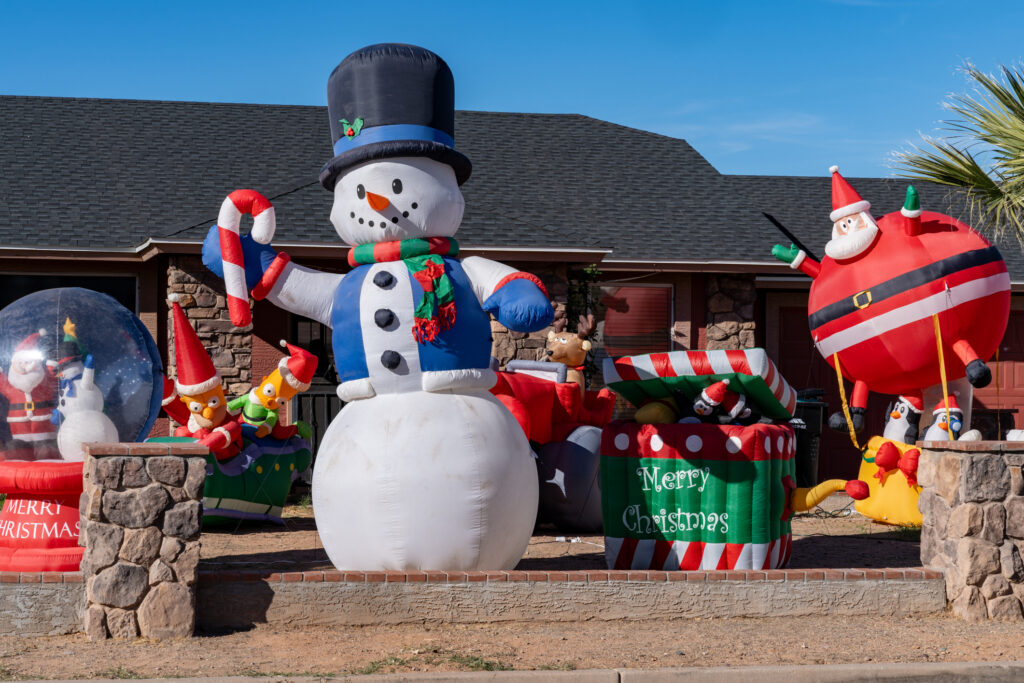Halloween decorations are going up in August. Christmas lights start in October. Your neighbor has an inflatable pumpkin the size of a car. When did holidays become competitive (and frightully expensive) decorating events?
The Halloween escalation is out of control. It’s not just pumpkins anymore—it’s animated skeletons, projection mapping, fog machines, professional-grade graveyards. You spend $500 to scare children for three hours. That’s $166 per hour of terror. (And that’s not even counting the candy!)
Christmas creep starts earlier every year. Stores put out decorations in September. You’re listening to Christmas music and buying artificial snow when it’s still 90 degrees out. The extended season extends the spending. Twelve days of Christmas? Try four months!
If you get really crazy with the sheer volume of decorations, you may need a storage unit. That can easily be $1,200 a year to store $500 worth of decorations. The decoration mortgage is real. Your inflatable reindeer has better housing than some people.
The inflatable decoration revolution was a mistake. Every yard has 10-foot inflatable everything. They cost hundreds, need constant power, and look tragic when deflated. Your electric bill doesn’t need a light-up dinosaur in a Santa hat.
LED conversion costs are hidden. Replacing all your old lights with LED seems smart until you realize you need new everything. That’s $300 in new lights to save $20 in electricity. That math won’t math for 15 years.
The neighborhood competition is destroying communities. That house with synchronized music and light shows? They spent $10,000. You feel inferior with your simple wreath. The Joneses have lost their damn minds and you’re still trying to keep up.
Pinterest destroyed reasonable expectations. Every mantel needs staging. Every door needs wreaths. Every surface needs seasonal transformation. You’re not decorating; you’re set designing. Your house is a holiday movie set nobody’s filming.
The themed tree multiplication is excessive. Main tree, kids’ tree, bedroom trees, bathroom trees? That’s $1,000 in trees for one holiday. Your house is a forest of artificial pine. The tree farm moved indoors.
Professional installation shame is real. Neighbors hiring companies for light installation while you’re on a ladder with tangled strings. They spent $2,000 for perfection. You risked your life for mediocrity.
The interior/exterior decoration divide doubled costs. Outside needs lights, inflatables, projectors. Inside needs trees, whole villages (with trains, even!), and garlands. It’s like you’re decorating two different properties. The inside and outside are in their own competition.
Seasonal dish sets are peak consumption. Christmas plates, Halloween cups, Thanksgiving silverware. Your cabinet is seasonal storage. You eat on different dishes based on the calendar. The dishware calendar is dystopian.
The village/train set addiction is model building with holiday themes. Hundreds of dollars in tiny buildings, fake snow, miniature people. The tiny town you’ve built for those miniature people is better decorated than the real town you live in.
Smart home holiday integration is expensive automation. Programmable lights, app-controlled displays, Alexa-activated decorations. Your decorations have better technology than your car. The IoT Christmas is here and it’s costly.
The post-holiday sales trap continues the cycle. “75% off! Stock up for next year!” You’re buying decorations in January for December. The cycle never ends. Your garage is a year-round Christmas store.
The environmental cost is ignored. Plastic decorations, energy consumption, disposable everything. You’re destroying the planet to celebrate it. The carbon footprint of your inflatable Santa is tragic irony.
Here’s the truth: Holidays were fine before decoration inflation. A simple wreath, some lights, maybe a tree. The decoration arms race isn’t bringing joy; it’s bringing debt and storage needs. Your neighbors don’t care. Your kids just want cookies.
Opt out. Decorate simply. Reuse everything. Make memories, not displays. The best holiday houses are the ones with happy people inside, not synchronized light shows outside. Your home’s value isn’t measured in lumens or inflatables. Let someone else win the decoration war while you enjoy the actual holiday.










